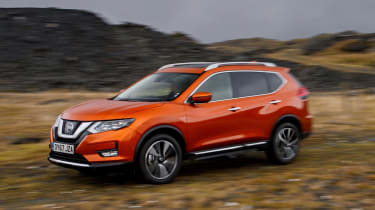Nissan X-Trail SUV (2013-2021) - Engines, drive & performance
It doesn’t offer boundless performance, but the Nissan X-Trail makes good use of what it has
To drive, the X-Trail feels rather like a bigger, more grown-up version of the Nissan Qashqai. The X-Trail is by no means a sprightly car to drive, but it handles competently, gripping well and allowing you to carry speed through the corners easily. The steering is well weighted and all versions are fitted with Chassis Control – a suite of electronic driver aids that includes Active Trace Control (to help steer the car safely around corners) and Active Ride Control (to stop the body getting too shaken up by bumpy roads).
Although soft suspension causes the X-Trail to lean heavily in corners, it soaks up lumps and bumps well. The ride is comfortable on the standard 17-inch alloys, but fidgety if you move up to the 18-inch wheels fitted to the N-Connecta version and especially the 19-inch wheels of the Tekna. Meanwhile, wind and road noise are only moderate, even at motorway speeds.
The X-Trail is less comfortable than the refined and supple Peugeot 5008, which is particularly adept at soaking up bumps, while the Skoda Kodiaq is more composed in corners and should appeal to keen drivers.
The optional four-wheel-drive system for the diesel model offers three useful modes: one keeps the car in two-wheel-drive setup, one switches into four-wheel drive if it detects a loss of grip, while the third mode makes the X-Trail fully four-wheel drive. However, it’s by no means essential and you can probably live without it unless you frequently encounter wintry conditions or rough terrain.
X-Trails built from 2020 that are fitted with a CVT automatic gearbox and ProPilot technology can make motorway driving much easier. ProPilot is a semi-autonomous driver assistance system that works during motorway driving to help with steering, braking and accelerating.
Petrol engine
The 1.3-litre petrol engine produces 158bhp and gives the X-Trail a 0-62mph time of 11.5 seconds. This is a quiet engine at lower revs and offers a hushed drive in town or on the motorway. It does, however, feel a little laboured; there's naturally less low-down power than the diesel, so that 0-62mph time feels longer than it actually is, as the engine has to be worked quite hard during brisk acceleration, where it emits a harsh engine note.
Nissan X-Trail diesel engines
The 1.7-litre diesel produced 148bhp, with reasonable low-speed pulling power, but it's now been discontinued. In two-wheel-drive form with a manual gearbox, the X-Trail will accelerate from 0-62mph in 10.7 seconds. That sounds quite brisk, but it only takes a small incline to blunt the car's progress. Maintaining speed requires frequent gearchanges, although once it's rolling the X-Trail can cruise with ease.













